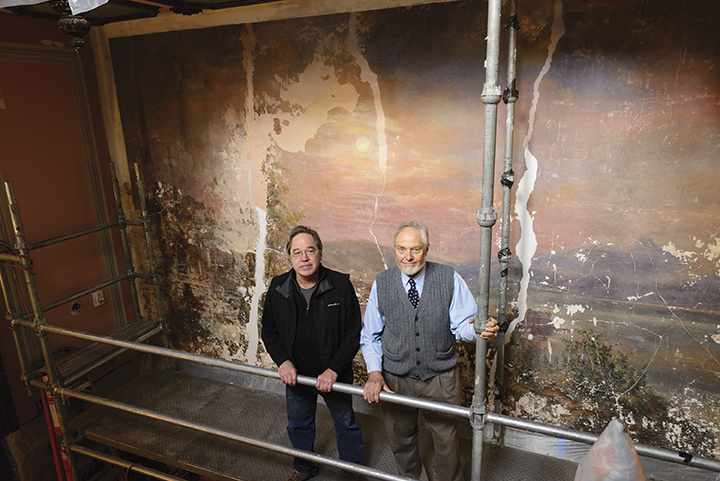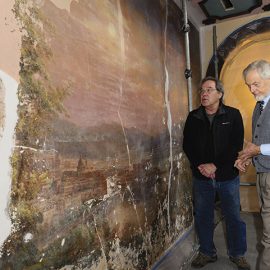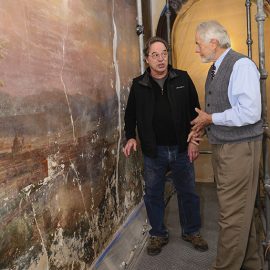Arts & Culture
City By The Bay
We go on a behind-the-scenes tour of Clifton Mansion.
It is hard to picture East Baltimore as rural, Italian-like countryside, but you can get a sense of the rolling hills and long-gone trees from Clifton Mansion, the former summer home of Johns Hopkins. Built atop 266 acres, its panoramic views of the Inner Harbor, downtown, and TV Hill make the busy thoroughfares of Harford and Belair roads below disappear. The undulating natural topography—buried beneath dense, century-old rowhouse-laden streets—suddenly becomes visible.
“It is one of the highest peaks in the city,” says John Ciekot, special projects director for the Clifton Mansion rehabilitation project, as he leads a mini-tour of the home, which includes an ongoing restoration of an 1851 Bay of Naples mural. “Horses and carriages would’ve rolled up the toll roads here to the private entrance.”
Hopkins acquired the property, originally owned by Captain Henry Thompson, in 1841, several years after the War of 1812 horse artillery and militia commander passed away. Baltimore’s most famous benefactor soon transformed the Captain’s stately Georgian mansion into an Italianate villa, complete with a new porte cochère (a covered entrance large enough for carriages to discharge their passengers) and an 80-foot tower. The entrance hall features richly stained arch window frames, a marble floor, ornate hand-painted walls and ceilings, a black walnut staircase—and the centerpiece, a mural of Naples, its great bay, the nearby countryside, and Mount Vesuvius.
The painting was discovered in 1993 when Civic Works, the nonprofit job training and community-service organization, began leasing the long-neglected property. ‘The mural was painted over probably a dozen times,” says Ciekot “Whatever bureaucratic beige, yellow, brown, or green was in that year.”
Gillian Quinn, who is leading the restoration of the mural, says period artists often painted the scene after a Vesuvius eruption, which made the bay sky glow.
The artist who did the mural remains unknown. However, a signature is beginning to be uncovered. This very afternoon, conservators Ewa Pohl and Sue Crawford are literally scraping back the layers of paint with scalpels, further revealing the blue-green bay hues and pink-rose sky. It’s tedious work that likely will take a year to complete, but not necessarily unpleasant. “It’s meditative,” Pohl says. “We’re like monks.”
The mural faces a large window whose golden light would have—and will again soon—made the painting look different in the morning, at noon, and at dusk. The work itself has been one of small discoveries. What Crawford thought was decades-old spackling turned out to be sailboats on the bay. Generally, the conservators work with knives in one hand and cloths in the other—dampened not by some high-tech chemical solution, but something readily available when the painting was made.
“Spit,” Pohl says, dabbing the mural wall. “It still works best.”
Additional questions about Clifton Mansion and tours can be sent to [email protected] or 2701 St. Lo Drive, Baltimore, MD 21213



